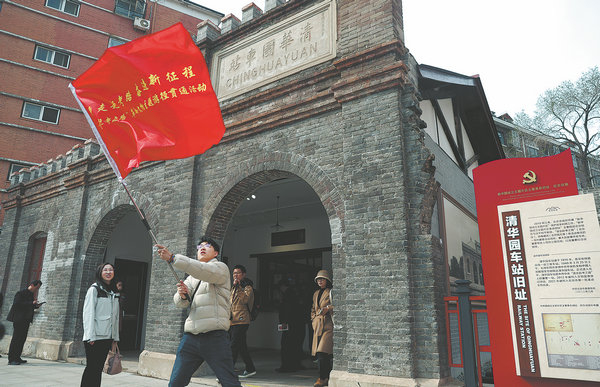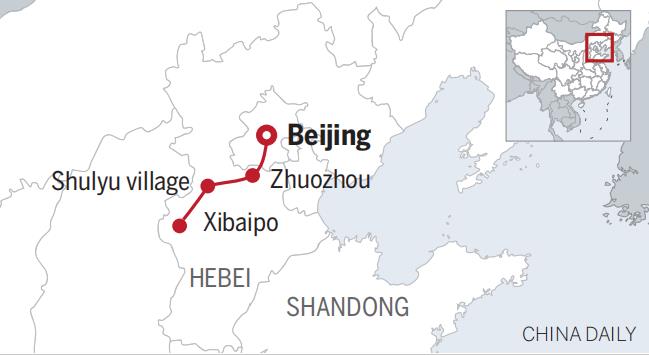
A ceremony is being held to celebrate the launch of the new travel route at Qinghuayuan Railway Station, one of the key locations along the route, on March 25. [Photo by Zou Hong/China Daily]
A new travel itinerary featuring the red cultural heritage was issued to commemorate a historic event 75 years ago, the Beijing Cultural Heritage Bureau and the Hebei Provincial Cultural Heritage Bureau announced at a ceremony in the capital in March.
The route dates back to March 1949, when the leadership of the Communist Party of China, under Mao Zedong, set out from what is now Sibaipo Village in Shijiazhuang, Hebei Province – a former command center of the Chinese Revolution. Their destination is Beijing, where they settle in the Xiangshan Mountains (or Fragrant Hills) to oversee the military campaign that eventually leads to the fall of the Kuomintang regime.
In October of the same year, the People’s Republic of China was founded.
Mao likened this momentous journey from Xibaipo to Beijing to “going to the capital for the grand examination,” referring to the imperial examination system of ancient China. This demonstrates the determination of leaders to meet new challenges.
The newly designated route, designed to commemorate this historic journey, connects various places along the way from Xibaipo to Xiangshan Mountain, including Shulyu Village in Tangxian County and Zhuozhou Railway Station in Hebei, as well as Qinghuayuan Railway Station, the Hall of Growing Longevity of the Summer Palace and Shuangqing Villa in Beijing.

A new travel route includes Xibaipo, Shulyu Village and Zhuozhou Railway Station in Hebei Province, as well as Qinghuayuan Railway Station, the Summer Palace and Shuangqing Villa in Beijing. [Photo provided to China Daily]
Chen Jiayi, a tour guide at Qinghuayuan Railway Station, said that the CCP leadership left Xibaipo on March 23, stopping at Shulyu Village, where Mao engaged in discussions with residents. They then boarded a train at Zhuozhou Railway Station, arriving at Qinghuayuan Railway Station in Beijing on March 25. Subsequently, they proceeded to the Summer Palace for rest and later inspected the troops at Xiyuan Airport before settling in the Shuangqing Villa on Xiangshan Mountain in the western outskirts of the city.
Chen Mingjie, head of the Beijing Cultural Heritage Bureau, says, “Through site visits, we will understand the challenges our ancestors faced in their struggles, thereby strengthening our determination to uphold their spirit and continue to we are striving for a new era. “
Among the sites, Qinghuayuan Railway Station has special significance as the first station where the CCP leadership arrived in Beijing and then moved to the Summer Palace, as Chen Jiayi notes.
The station was on the Beijing-Zhangjiakou Railway, which has the distinction of being the first railway to be designed and constructed exclusively by Chinese engineers. The railway, envisioned by Zhang Tianyu, a respected engineer revered as the “Father of the Chinese Railway”, began construction in 1905 and was completed four years later during the late Qing Dynasty (1644-1911), culminating in the establishment of Tsinghuayuan Station.
An exhibit at the station shows a segment of the original steel rail used on the Beijing-Zhangjiakou Railway. “The rail bears inscriptions indicating its purchase by a French company from the Imperial Chinese Railway in 1905,” says Chen Jiayi.
“This station played a crucial role in the journey of the CCP leadership to Beijing, marking a significant shift in the heart of the Chinese revolution from rural to urban settings and representing the historic moment when CCP members entered Beijing.”
During the ceremony in March, an initiative was launched to preserve the cultural relics associated with the “going to the capital of the big exam” event. The initiative emphasizes the need for enhanced conservation and scientific research of cultural heritage, the establishment of coordination mechanisms for the preservation of such relics, their revitalization and their integration into tourism in order to stimulate future development.

